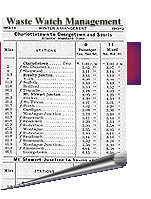
 Since 1995, households and
businesses in East Prince have been making a vital
contribution to the preservation of our valuable farmland
and priceless drinking water by sorting the waste they
generate. This Waste Watch program, that was the first of
its kind in Canada, got its start in 1990. At this time,
the St. Eleanors landfill site was running out of space,
but none of the ten communities that had been served by
the facility wanted to have a similar site established in
their backyard. At the suggestion of the provincial
government, the ten communities pooled their resources
and devised an alternative waste handling system. In
1991, the East Prince Waste Management Commission was
established and consisted of volunteers from these
communities. The Commission, in turn, initiated a pilot
project that, at its peak, incorporated 1,000 households
and businesses.
Since 1995, households and
businesses in East Prince have been making a vital
contribution to the preservation of our valuable farmland
and priceless drinking water by sorting the waste they
generate. This Waste Watch program, that was the first of
its kind in Canada, got its start in 1990. At this time,
the St. Eleanors landfill site was running out of space,
but none of the ten communities that had been served by
the facility wanted to have a similar site established in
their backyard. At the suggestion of the provincial
government, the ten communities pooled their resources
and devised an alternative waste handling system. In
1991, the East Prince Waste Management Commission was
established and consisted of volunteers from these
communities. The Commission, in turn, initiated a pilot
project that, at its peak, incorporated 1,000 households
and businesses. The East Prince Waste Management Facility is located in Wellington, on 200 hectares buffered from the nearest body of water by 450 metres of land. The facility includes a scale house, compost building and a sanitary landfill. Large appliances, metals, tires, hazardous household materials, and residential recyclables are stored in separate areas until they are properly disposed of or redistributed.
The program is based on four principles:
- Each of us is responsible for the management of our own waste;
- Most materials we used to call “garbage” are actually “resources” that can be reused, recycled, or composted;
- Waste separation at the source is the least expensive and most effective option for management;
- We are responsible today for the state of the environment that we leave to future generations.
During the initial trial period, the commission and
participants experimented with different receptacles,
pick-up schedules, and separation procedures before
settling on the system they ultimately put in place. In
1997, the Province created a new Prince Edward Island
Waste Management Commission that was to plan and
implement a province-wide waste management regime
modelled after the East Prince system. In April of 1998,
the new commission and the East Prince Waste Management
Commission were amalgamated to create the Island Waste
Management Commission to manage the implementation of the
provincial strategy.
In 1989, the Canadian Council of Ministers of the
Environment committed their provinces to the goal of 50
percent waste reduction that is sent to landfills by the
year 2000. In each year of its existence, the East Prince
Waste Management Commission has diverted more than 60
percent of the waste stream. 1995 saw 60.5 percent
diversion, 1996 saw 64.8 percent, and 1997 saw a
diversion rate of 65.6 percent. Over 30 percent of waste
ends up as compost (which is then sold to consumers), 20
percent is recycled, and 13 percent is reclaimed through
other programs. The remaining 25 percent ends up in a
sanitary landfill.
Police | Fire | Education | Health | Government